Laws of Motion
Question 1. A balloon of mass m is descending with an acceleration a (where a < g). How much mass must be removed from it so that it starts rising up with the same acceleration?
- \(\frac{2 m a}{g+a}\)
- \(\frac{2 m a}{g-a}\)
- \(\frac{m a}{g+a}\)
- \(\frac{m a}{g-a}\)
Answer: 1. \(\frac{2 m a}{g+a}\)
Let F be the upthrust. So, mg >F for the downward motion.
∴ mg-F-ma ………….(1)
Let a mass m0 be removed so that the balloon starts rising up with the
same acceleration.
∴ F-(m- m0)g = (m-m0)a …………..(2)
Adding (1) and (2),
m0g = 2ma – m0a.
the mass to be removed is \(m_0=\frac{2 m a}{a+g}\)
Question 2. A force F is applied horizontally to block A of mass m1 which is in contact with block B of mass m2 as shown in the figure. If the surfaces are smooth, the contact force exerted by A on B is
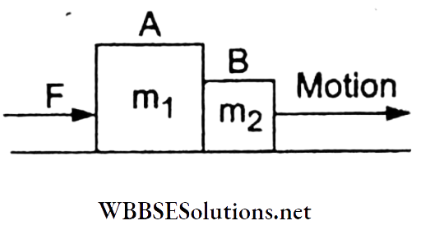
- \(\frac{m_2 F}{m_1}\)
- \(\frac{m_1 F}{m_2}\)
- \(\frac{m_1 F}{m_1+m_2}\)
- \(\frac{m_2 F}{m_1+m_2}\)
Answer: 4. \(\frac{m_2 F}{m_1+m_2}\)
Let the contact force between the blocks A and B be f.
From the free-body diagram of the block A shown,
F-f= m1a …………(1)
Similarly, for B,
f = m2a,
where a is the common acceleration.
Adding (1) and (2),
F = (m1 + m2)a
⇒ \(a=\frac{F}{m_1+m_2}\)
Substituting for a in (2), we get the contact force
⇒ \(f=\frac{m_2 F}{m_1+m_2}\)
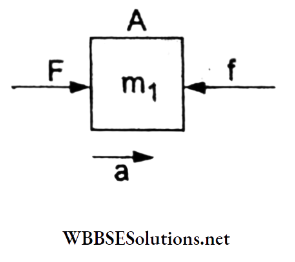
Question 3. A block of mass m2 lying on a smooth horizontal surface is connected to a block of mass mx by means of a string, which passes over a frictionless pulley, as shown in the figure. The common acceleration of the blocks is
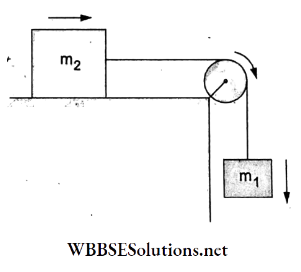
- \(\left(\frac{m_1}{m_1+m_2}\right) g\)
- \(\left(\frac{m_2}{m_1+m_2}\right) g\)
- \(\left(\frac{m_1}{m_2}\right) g\)
- \(\left(\frac{m_2}{m_1}\right) g\)
Answer: 1. \(\left(\frac{m_1}{m_1+m_2}\right) g\)
Let a be the common acceleration of the system and T be the tension in
the string.
For m1, m1g-T = m1a.
For m2, T = m2a
Adding, we get
m1g = (m1 + m2)a
∴ The common acceleration is
⇒ \(a=\left(\frac{m_1}{m_1+m_2}\right) g\)
Question 4. A block of mass M and length L is pulled horizontally by a force F. The tension in the block at a distance x from the force end is
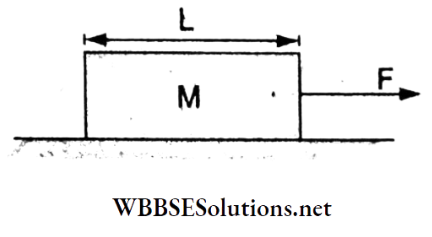
- \(\left(\frac{x}{L}\right) F\)
- \(\left(\frac{L}{x}\right) F\)
- \(\left(1-\frac{x}{L}\right) F\)
- \(\left(1+\frac{L}{x}\right) F\)
Answer: 3. \(\left(1-\frac{x}{L}\right) F\)
The mass per unit length of the block is \(\frac{M}{L}\). So, the mass of the length is,
⇒ \(\frac{M x}{L}\).
From the free-body diagram of block A,
⇒ \(F-f=\left(\frac{M x}{L}\right) a\) ……(1)
where the acceleration of the block is
⇒ \( a=\frac{F}{M}\)
From (1), we obtain the contact force (tension)
⇒ \(f=F-\frac{M x}{L} \cdot \frac{F}{M}=\left(1-\frac{x}{L}\right) F\)
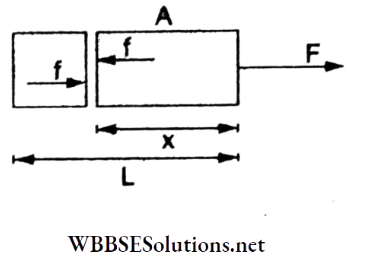
Question 5. In the given figure, F1 and F2 (where F1 > F2) are two forces acting horizontally in opposite directions on a block of mass M and length L. What is the tension in the block at a distance x from the right end?
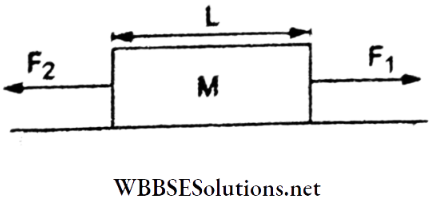
- \(F_1\left(1+\frac{x}{L}\right)+\left(\frac{F_2}{L}\right) x\)
- \(F_1\left(1-\frac{x}{L}\right)+\left(\frac{F_2}{L}\right) x\)
- \(\frac{x}{L}\left(F_1+F_2\right)\)
- \(\frac{x}{L}\left(F_1-F_2\right)\)
Answer: 2. \(F_1\left(1-\frac{x}{L}\right)+\left(\frac{F_2}{L}\right) x\)
Let the net acceleration of the block be a. So,
⇒ \(a=\frac{F_{\text {net }}}{m}=\frac{F_1-F_2}{m}\)
The free-body diagram is shown in the adjoining figure.
The mass of the part A Of the blocks
⇒ \(\frac{M x}{L}\)
Hence, from the laws of motion,
⇒ \(F_1-f=\left(\frac{M x}{L}\right)\)
Substituting for a, we get
⇒ \(f=F_1-\frac{M x}{L} \cdot \frac{F_1-F_2}{M}=F_1\left(1-\frac{x}{L}\right)+\left(\frac{F_2}{L}\right) x .\)
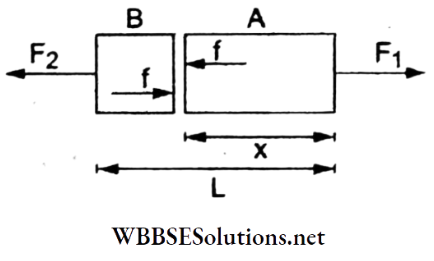
Question 6. Two blocks A and B of respective masses m1 and m2 are connected by a light string and placed over a smooth horizontal surface. The blocks are pulled by forces F1 and F2 respectively, as shown in the figure. The tension in the string connecting A and B is
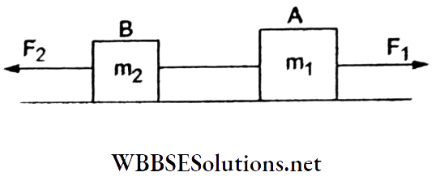
- \(\left(F_1+F_2\right)\left(\frac{m_1-m_2}{m_1+m_2}\right)\)
- \(\left(F_1-F_2\right)\left(\frac{m_1-m_2}{m_1+m_2}\right)\)
- \(F_1\left(\frac{m_2}{m_1+m_2}\right)+F_2\left(\frac{m_1}{m_1+m_2}\right)\)
- \(F_1\left(\frac{m_1}{m_2}\right)+F_2\left(\frac{m_2}{m_1}\right)\)
Answer: 3. \(F_1\left(\frac{m_2}{m_1+m_2}\right)+F_2\left(\frac{m_1}{m_1+m_2}\right)\)
Let T be the tension in the connecting string. The free-body diagrams of the blocks are shown in the figure.
Let a be the common acceleration of the system to the right. (The tension always acts away from the contact point.)
For m1, F1-T = mxa.
For m2, T-F2 = m2a.
Adding, we get
F1-F2 = (m1 + m2)a.
∴ The common acceleration is
⇒ \(a=\frac{F_1-F_2}{m_1+m_2}\)
⇒ \(T=F_1-m_1 a=F_1-m_1\left(\frac{F_1-F_2}{m_1+m_2}\right)\)
⇒ \(F_1\left(\frac{m_2}{m_1+m_2}\right)+F_2\left(\frac{m_1}{m_1+m_2}\right)\)

Question 7. Both the springs shown in the figure are unstretched. If the block of mass m is shifted by a distance ki x on either side and then released, m what will be the initial acceleration?
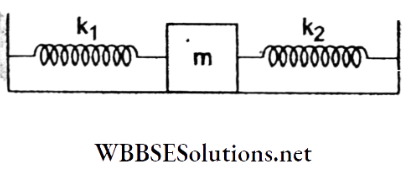
- \(\left(\frac{k_1+k_2}{m}\right) x\), in the direction of its displacement
- \(\left(\frac{k_1+k_2}{m}\right) x\), opposite to the direction of the displacement
- \(\left(\frac{k_1}{m}\right) x\) when pressed by
- \(\left(\frac{k_2}{m}\right) x\) when pressed by kx
Answer: 2. \(\left(\frac{k_1+k_2}{m}\right) x\), opposite to the direction of the displacement
From the free-body diagram shown, Fnet = (k1 + k2) to the left.
∴ The acceleration is
⇒ \(a=\frac{F_{\text {net }}}{m}=\left(\frac{k_1+k_2}{m}\right) x\)
opposite to the displacement
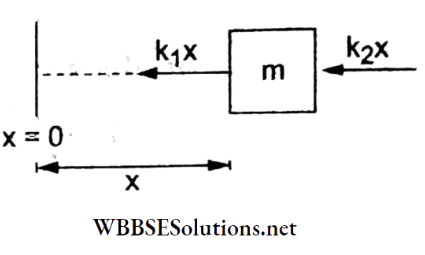
Question 8. A block of mass m = 0.3 kg is pressed against a spring of force constant k = 15 N m-1. If the block compresses the spring by 20 cm and is released, what will be its initial acceleration?
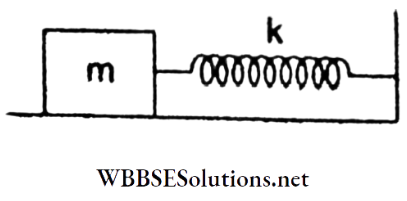
- 5 m s-1
- 10 ms-1
- 15 ms-1
- 20 ms-1
Answer: 2. 10 ms-1
The force on the block Just before its release is F = kx.
Hence, the initial acceleration is
⇒ \(a=\frac{F}{m}=\frac{k x}{m}=\frac{\left(15 \mathrm{~N} \mathrm{~m}^{-1}\right)\left(20 \times 10^{-2} \mathrm{~m}\right)}{0.3 \mathrm{~kg}}=10 \mathrm{~m} \mathrm{~s}^{-2}\)
Question 9. A block of mass m1 = 0.2 kg is suspended from the ceiling by a light string. A second block of mass m2 = 0.3 kg is suspended from the first block by another string. The ratio \(\frac{T_1}{T_2}\) of the tensions in the two strings is
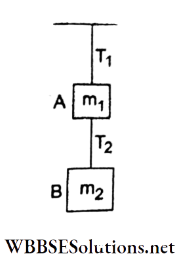
- \(\frac{3}{5}\)
- \(\frac{2}{3}\)
- \(\frac{5}{3}\)
- \(\frac{4}{5}\)
Answer: 3. \(\frac{5}{3}\)
For block B, T2 = m2g,
and for block A,
⇒ \(T_1=T_2+m_1 g=m_2 g+m_1 g=\left(m_2+m_1\right) g\)
∴ \(\frac{T_1}{T_2}=\frac{m_1+m_2}{m_2}=\frac{0.2 \mathrm{~kg}+0.3 \mathrm{~kg}}{0.3 \mathrm{~kg}}=\frac{5}{3}\)
Question 10. A force of \(\vec{F}=(4 \hat{i}+3 \hat{j}-5 \hat{k})\) N applied on a block of mass m produces an acceleration of √2 m s-2. The value of m is
- √2 kg
- 5√2 kg
- 5 kg
- 2√5kg
Answer: 3. 5 kg
The magnitude of the applied force is
⇒ \(|\vec{F}|=|4 \hat{i}+3 \hat{j}-5 \hat{k}| \mathrm{N}=\sqrt{16+9+25} \mathrm{~N}\)
⇒ \(5 \sqrt{2} \mathrm{~N}\)
Given that acceleration = \(|\vec{a}|=\sqrt{2} \mathrm{~ms}^{-2}\)
∴ \(\text { mass }=m=\frac{F}{a}=\frac{5 \sqrt{2} \mathrm{~N}}{\sqrt{2} \mathrm{~ms}^{-2}}=5 \mathrm{~kg}\)
Question 11. A thick uniform rope of mass 6 kg and length 3 m is hanging vertically from a rigid support. The tension in the rope at a point 1 m below the support will be (taking g = 10 m s-2)
- 20 N
- 40 N
- 30 N
- 60 N
Answer: 2. 40 N
The mass—per unit=-length= of the rope is \(\frac{6 \mathrm{~kg}}{3 \mathrm{~m}}=2 \mathrm{~kg} \mathrm{~m}^{-1}\). The tension T at a distance x = 1 m from the support equals the weight of the length (3 m-1 m = 2 m) of the rope, Thus,
T = (2 kg m-1)(2 m)g = 40 N.
Question 12. A block is lying on a frictionless horizontal surface. One end of a uniform rope is fixed to the block and the other end is pulled horizontally by a force F. If the mass of the rope is half the mass of the block, the tension at the midpoint of the rope will be
- F
- \(\frac{5}{6} F\)
- \(\frac{2}{3} F\)
- \(\frac{3}{5} F\)
Answer: 2. \(\frac{5}{6} F\)
Let m and 2m be the mass of the rope and that of the block respectively.
The acceleration of the system is \(a=\frac{F}{3 m}\)
If T be the tension at the midpoint of the rope then
⇒ \(F-T=\left(\frac{m}{2}\right) a=\left(\frac{m}{2}\right)\left(\frac{F}{3 m}\right)=\frac{F}{6}\)
∴ Tension = \(T=F-\frac{F}{6}=\frac{5 F}{6}\)
Question 13. A person is sitting in a compartment facing the engine of a moving train. He tosses a coin upwards. The coin falls behind him. This shows that the train is moving
- Forward with a finite acceleration
- Forward with a finite deceleration
- Forward with a uniform speed
- Backward with a uniform speed
Answer: 1. Forward with a finite acceleration
When the coin is with the person, it shares the acceleration of the train.
When he tosses the coin, it falls behind him opposite to the direction of the accelerated motion of the train. Hence, the train is moving forward with a finite acceleration.
Question 14. A man weighing w = Mg is standing in a lift that is moving upwards with an acceleration a. The apparent weight of the man is
- w
- \(w\left(1-\frac{a}{g}\right)\)
- \(w\left(1+\frac{a}{8}\right)\)
- \(w\left(\frac{a}{g}\right)\)
Answer: 3. \(w\left(1+\frac{a}{8}\right)\)
We feel our weight by the normal reaction (tW ) offered by the surface we stand on. The free-body diagram of the man standing in the moving lift is shown in the adjoining figure.
Fnet = N-mg = ma, so the apparent weight is
⇒ \(w=\mathcal{N}=m g+m a=m g\left(1+\frac{a}{g}\right)=w\left(1+\frac{a}{g}\right)\)
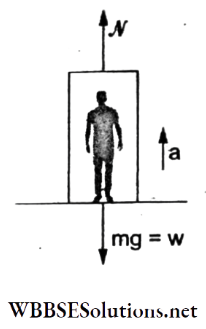
Question 15. A particle moves in the xy-plane under the influence of a force such that its linear momentum is given by \(\vec{p}(t)=A[(\cos b t) \hat{i}-(\sin b t) \hat{j}]\) where A and b are constants. The angle between the force and the momentum is
- 0°
- 30°
- 60°
- 90°
Answer: 4. 90°
Linear momentum = \(\vec{p}=A[(\cos b t) \hat{i}-(\sin b t) \hat{j}]\)
Hence,\(\vec{F}=\frac{d \vec{p}}{d t}=A b[-(\sin b t) \hat{i}-(\cos b t) \hat{j}]\)
∴ \(\vec{p} \cdot \vec{F}=A^2 b[(\cos b t) \hat{i}-(\sin b t) \hat{j}] \cdot[(-\sin b t) \hat{i}-(\cos b t) \hat{j}]\)
= -A²b[sinbtcosbt-cosbtsinbt]
= 0.
Hence,
\(\vec{p} \text { and } \vec{F}\)are mutually inclined at 90°.
Question 16. Two blocks A and B of masses 2m and m respectively are connected by a light string and attached to a light spring suspended from a rigid support. The system is at rest in equilibrium. If the string connecting A and B is suddenly cut, the magnitudes of the accelerations of A and B at that instant are respectively
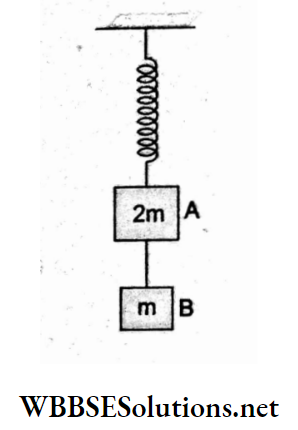
- g and g
- \(g \text { and } \frac{g}{2}\)
- \(\frac{g}{2} \text { and } g\)
- \(\frac{g}{2} \text { and } \frac{g}{2}\)
Answer: 3. \(\frac{g}{2} \text { and } g\)
When the system is in equilibrium, the spring force acting on block A is 3mg (upward). When the string is cut, the forces acting on the block
A is the spring force is 3mg (upward) and its weight is 2mg (downward).
Then, the upward net force is 3mg- 2mg = mg.
∴ acceleration of the block A at this instant is,
⇒ \(a_{\mathrm{A}}=\frac{F_{\text {net }}}{2 m}=\frac{m g}{2 m}=\frac{g}{2}\)
At the same instant, block B will fall freely under gravity with the accelerationg.
Question 17. A string of negligible mass passing over a clamped pulley of mass m supports a block of mass M as shown in the adjoining figure. The force exerted on the pulley by the clamp is
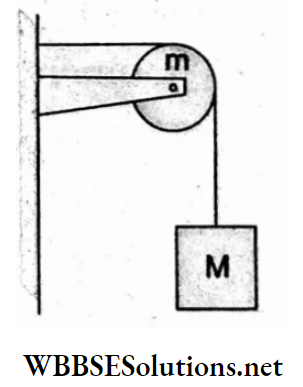
- \(\sqrt{2} \cdot M g\)
- \(\sqrt{2} \cdot m g\)
- \(\sqrt{(M-m)^2+m^2} \cdot g\)
- \(\sqrt{(M+m)^2+M^2} \cdot g\)
Answer: 4. \(\sqrt{(M+m)^2+M^2} \cdot g\)
The forces acting on the pulley are the tension T = Mg (along the horizontal) and T + mg (vertically downward).
Hence, the net force on the clamp is the resultant
⇒ \(\sqrt{T^2+(T+m g)^2}=\sqrt{M^2+(M+m)^2} \cdot g .\)
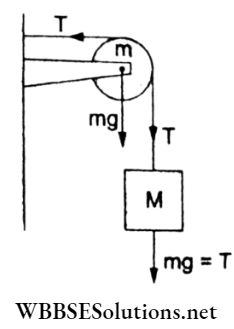
Question 18. A block is released from the top of an inclined plane of height h and angle of inclination 0. The time taken by the block to reach the bottom of the plane is given by
- \(\sqrt{\frac{2 h}{g}}\)
- \(\sin \theta \sqrt{\frac{2 h}{g}}\)
- \(\frac{1}{\cos \theta} \sqrt{\frac{2 h}{8}}\)
- \(\frac{1}{\sin \theta} \sqrt{\frac{2 h}{g}}\)
Answer: 4. \(\frac{1}{\sin \theta} \sqrt{\frac{2 h}{g}}\)
The component of the acceleration due to gravity along the inclined plane is g sin θ and the distance covered along the plane is
⇒ \(s=\frac{h}{\sin \theta}\)
Now, \(s=\frac{1}{2} a t^2\)
∴ \(t=\sqrt{\frac{2 s}{a}}=\sqrt{\frac{2\left(\frac{h}{\sin \theta}\right)}{g \sin \theta}}=\frac{1}{\sin \theta} \sqrt{\frac{2 h}{g}}\)
Question 19. N bullets, each of mass m, are fired with a velocity v, at the rate of n bullets per second upon a wall. The bullets come to rest after hitting the wall. The reaction exerted on each bullet by the wall is
- Nnmv
- \(\frac{m v n}{N}\)
- mvn
- \(\frac{N v m}{n}\)
Answer: 3. mvn
The initial momentum of each bullet is mv, and the change in momentum is mv- 0 = mv. The number of bullets striking the wall in one second is n.
Hence, the rate of change of momentum is F = mvn.
Question 20. A stream of liquid of density p flowing horizontally at a speed v gushes out of a tube of radius r and hits a vertical wall normally. Assuming that the liquid does not rebound from the wall, the force exerted on the wall by the liquid is
- \(\pi r \rho v^2\)
- \(\pi r \rho v\)
- \(\pi r^2 \rho v\)
- \(\pi r^2 \rho v^2\)
Answer: 4. \(\pi r^2 \rho v^2\)
Given that the cross-sectional area of the tube is A- nr2 and the speed of the liquid is v. the mass of the liquid flowingout per unit time is Avp.
Since the liquid does not rebound after striking the wall, the net rate of change of momentum is
F = mass flowing out per unit time x velocity
⇒ \((A v \rho) v=\pi r^2 \rho v^2\)
Question 21. A cricket ball of mass 150 g moving at a velocity of 12 m s-1 is hit by a bat so that the ball is turned back with a velocity of 20 m s-1. The impact lasts for 0.1 s. The average force exerted by the bat on the ball is
- 60 N
- 48 N
- 18 N
- 30 N
Answer: 4. 30 N
Initial momentum of the ball -mv- (150 g)(12 m s_1) = 1.8 kg m s-1.
Final momentum of the ball = mv’- (150 g)(-20 m s-1) =-3 kg m s-1.
∴ Change in momentum = Ap = [1.8- (-3)] kg m s-1 = 4.8 kg m s-1.
∴ Average 6 force = \(F=\frac{\Delta p}{\Delta t}=\frac{4.8 \mathrm{~kg} \mathrm{~m} \mathrm{~s}^{-1}}{0.1 \mathrm{~s}}=48 \mathrm{~N}\)
Question 22. Two billiard balls, each of mass 50 g, moving in opposite directions, each at a speed of 6 m s-1, collide and rebound with the same speed. The impulse imparted to each ball by the other is
- 0.6 Ns
- 1.2 Ns
- 0.3 Ns
- 0.9 Ns
Answer: 1. 0.6 Ns
The change in momentum is Ap = mu- (-mu)
= 2mu
⇒ \(2\left(\frac{50}{1000} \mathrm{~kg}\right)\left(6 \mathrm{~ms}^{-1}\right)\)
= 0.6 kg m s-1.
Hence, impulse = change in momentum = 0.6
Question 23. The force F acting on a particle of mass m is represented by the force-time graph shown in the following figure. The change in the momentum of the particle over a time interval from zero to 8 s is
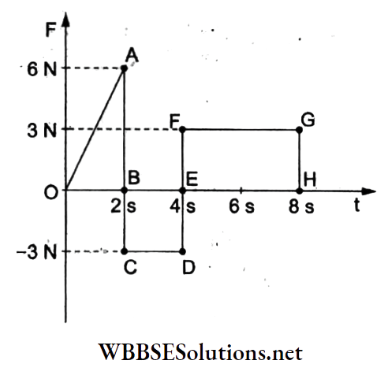
- 24 N s
- 20Ns
- 12Ns
- 6Ns
Answer: 3. 12Ns
The area under the F-f graph is
⇒ \(\int F d t=\int \frac{d p}{d t} d t=\int_{p_i}^{p_f} d p=p_f-p_i\) = change in momentum.
Hence, a change in momentum

= \(\frac{1}{2}\) (2 s)(6 N)- (2 s)(3 N) + (4 s)(3 N)
= 12 N s
Question 24. Three blocks A, B and C of respective masses m, 2m, and 3m are connected by strings, as shown in the adjoining figure. After an upward force, F is applied on the block A, the masses move upwards at a constant speed v. What is the net force on the block B (g being the acceleration due to gravity)?
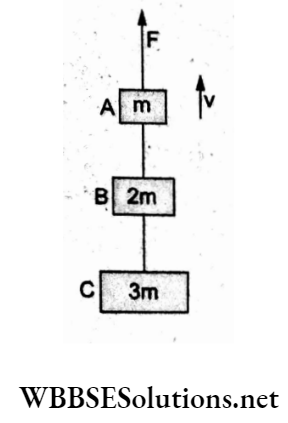
- 3mg
- 2mg
- 6mg
- Zero
Answer: 4. Zero
It is given that the system of masses moves upwards at a constant speed. The net acceleration is zero, so the net force on each mass will be zero.
This can be explained as follows:
For the block A,
F-T1-mg= 0
T1 = F-mg.
For the block B,
T1– 2mg – T2 = 0
T2 = T1– 2mg
= F-3mg.
For the block C,
T2-3mg = 0
=> T2 = 3mg.
Hence, the net force on the block B will be
T1– 2mg-T2 =(F- mg)- 2mg- (F-3mg) = 0.
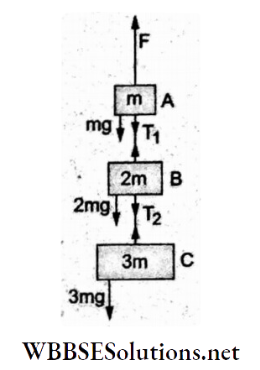
Question 25. Sand is being dropped on a conveyor belt at the rate of M kg s-1. The force necessary to keep the belt moving at a constant velocity v m s-1 will be
- \(\frac{M v}{2} \mathrm{~N}\)
- MuN
- 2MvN
- zero
Answer: 2. MuN
Force \(F=\frac{d p}{d t}=\frac{d}{d t}(m v)=m \frac{d v}{d t}+v \frac{d m}{d t}\)
Since the belt is moving with a constant velocity, \(\frac{d v}{d t}=0\) and hence
⇒ \(F=v \frac{d m}{d t}=v M \mathrm{~N}, \text { where } \frac{d m}{d t}=M \mathrm{~kg} \mathrm{~s}^{-1}\)
∴ The required force is F = Mv N
Question 26. A 600-kg rocket is set for a vertical launch. If the exhaust speed of the fuel is 1000 m s-1, the mass of the gas ejected per unit time to supply the thrust needed to overcome the weight of the rocket is
- 117.6 kg s-1
- 58.6 kgs-1
- 76.4 kg s-1
- 6 kgs-1
Answer: 4. 6 kgs-1
Given that M = 600 kg and the exhaust speed of the fuel relative to the rocket = u = 10³ m s-1.
Let the rate of burning of the fuel be \(\mu=\frac{d m}{d t}\)
We know that the force imparted by the burning fuel is F = um, which will just lift the rocket. So,
\(u \mu=M g \Rightarrow \mu=\frac{d m}{d t}=\frac{M g}{u}=\frac{(600 \mathrm{~kg})\left(10 \mathrm{~m} \mathrm{~s}^{-2}\right)}{1000 \mathrm{~m} \mathrm{~s}^{-1}}=6 \mathrm{~kg} \mathrm{~s}^{-1}\).
Question 27. In a rocket, the fuel bums at the rate of 1 kg s-1. This fuel is ejected from the rocket with a velocity of 60 km s-1. The force exerted by the burning fuel on the rocket is
- 6 x 10³ N
- 6 x 104 N
- 60N
- 600N
Answer: 2. 6 x 104 N
Force,
⇒ \(F=u \mu=u \frac{d m}{d t}=\left(60 \times 10^3 \mathrm{~m} \mathrm{~s}^{-1}\right)\left(1 \mathrm{~kg} \mathrm{~s}^{-1}\right)=6 \times 10^4 \mathrm{~N}\).
Question 28. A 5000-kg rocket is set for vertical firing. The exhaust speed is 800 m s-1. To impart an initial upward acceleration of 20 m s-2, the amount of gas ejected per unit time to supply the thrust needed will be (assuming g = 10 m s-2)
- 185.5 kg s-1
- 187.5 kgs-1
- 127.5 kgs-1
- 137.5 kgs-1
Answer: 2. 187.5 kgs-1
The net force (upward) on the rocket is
⇒ \(F=u \frac{d m}{d t}-M g=M a\)
∴ The rate at which gas is ejected per unit time is
⇒ \(\frac{d m}{d t}=\frac{M(a+g)}{u}=\frac{\left(5 \times 10^3 \mathrm{~kg}\right)\left(30 \mathrm{~m} \mathrm{~s}^{-2}\right)}{800 \mathrm{~m} \mathrm{~s}^{-1}}\)
⇒ \(\frac{1500}{8} \mathrm{~kg} \mathrm{~s}^{-1}=187.5 \mathrm{~kg} \mathrm{~s}^{-1}\)
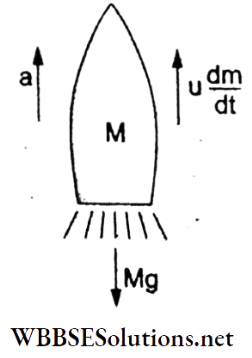
Question 29. If the force on a rocket moving at a velocity of 300 m s-1 is 210 N, the rate of combustion of the fuel is
- 0.07 kgs-1
- 1.4 kgs-1
- 0.7 kg s-1
- 10.7 kgs-1
Answer: 3. 0.7 kg s-1
Given that the speed of the rocket = u = 300 m s-1 and force = F- 210 N.
∵ \(F=u \frac{d m}{d t}\)
∴ rate of burning
⇒ \(\frac{d m}{d t}=\frac{F}{u}=\frac{210 \mathrm{~N}}{300 \mathrm{~m} \mathrm{~s}^{-1}}=0.7 \mathrm{~kg} \mathrm{~s}^{-1}\)
Question 30. An elastic spring has a length l1 when stretched by a force of 2N and a length l2 when it is stretched by a force of 3N. What will be the length of the spring when it is stretched by a force of 5N?
- l1 + l2
- 3l1 – 2l2
- 3l2 – 2l1
- \(\frac{l_1+l_2}{2}\)
Answer: 3. 3l2 – 2l1
For an ideal spring, force α stretch.
Let 10 be the unstretched length. Then,
⇒ \(2 \mathrm{~N}=k\left(l_1-l_0\right) \text { and } 3 \mathrm{~N}=k\left(\dot{l}_2-l_0\right)\)
∴ \(\frac{2 \mathrm{~N}}{3 \mathrm{~N}}=\frac{l_1-l_0}{l_2-l_0} \Rightarrow l_0=3 l_1-2 l_2\)
When the stretching force is 5 N, we have
⇒ \(5 \mathrm{~N}=k\left(l_3-l_0\right)\)
∴ \(\frac{5 \mathrm{~N}}{2 \mathrm{~N}}=\frac{l_3-l_0}{l_1-l_0}\)
Substituting l0 from (1) and simplifying
⇒ \(2 l_3=5 l_1-3 l_0^{\prime} \Rightarrow l_3=3 l_2-2 l_1\)
Question 31. The linear momentum p of a body of mass m varies with the time t as p = 4t² + 2, where p is in kilogram metres per second and t is in seconds. It follows that the body is moving with a
- Constant velocity
- Constant acceleration
- Variable acceleration
- Variable retardation
Answer: 3. Variable acceleration
Given that linear momentum = p = 4t² + 2.
∴ Force = \(F=\frac{d p}{d t}=8 t\)
∴ Instantaneous acceleration = \(a=\frac{F}{m}=\frac{8}{m}(t)\)
This acceleration is time-dependent and hence variable.
Question 32. A shell of mass m is initially at rest. It explodes into three fragments of masses in the ratio 2:2:1. The two fragments having equal masses fly off along mutually perpendicular directions with a speed v. What will be the speed of the third fragment?
- v
- √2v
- 2√2 v
- 3√2v
Answer: 3. 2√2 v
The total mass m of the shell is divided in the ratio 2:2:1. Hence, the masses are respectively
⇒ \(\frac{2 m}{5}, \frac{2 m}{5} \text { and } \frac{m}{5}\)
Let the equal fragments flying in perpendicular directions have the velocity v each. So, their resultant momentum has the magnitude
⇒ \(p=\sqrt{\left(\frac{2 m}{5} v\right)^2+\left(\frac{2 m}{5} v\right)^2}=\frac{2 \sqrt{2} m v}{5}\)
From the principle of conservation of linear momentum, we have
⇒ \(\left(\frac{m}{5}\right) v^{\prime}=\frac{2 \sqrt{2} m v}{5} \Rightarrow v^{\prime}=2 \sqrt{2} \tau\)
Question 33. Bullets of mass 30 g each hit a wall at the rate of 200 bullets per second at a speed of 50 m s-1 and rebound at 30 m s. The average force exerted on the wall is
- 120 N
- 480 N
- 180 N
- 300 N
Answer: 2. 480 N
The change of momentum of one bullet after it rebounds is
m(v- u) = (30 g)[50 m s-1– (-30 m s-1)]
= 2.4 kg m s-1.
∴ Average force = change of momentum per unit time
= (2.4 kg m s-1)(200 s-1)
= 480 N.
Question 34. A block of mass 10 kg is kept on a rough inclined plane as shown in the adjoining figure. A force of 3 N is applied on the block. The coefficient of static friction between the plane and the block is 0.6. What should be the minimum value of the force F such that the block does not move downwards?
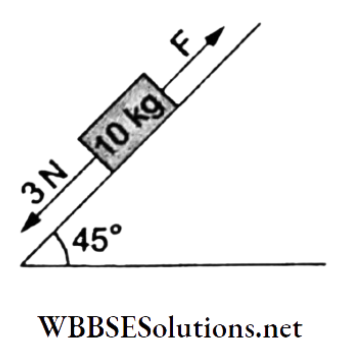
- 32 N
- 25 N
- 23 N
- 18 N
Answer: 1. 32 N
The forces acting on, the block are shown in the given free-body diagram.
Here, normal reaction N = mg cos θ. Hence, limiting frictional force \(f_{\max }=\mu \propto N=\mu m g \cos \theta\). When the block has the tendency to slip down the plane, friction acts upwards and the minimum force F will be such
⇒ \(\mathrm{F}+f_{\max }=m g \sin \theta+3 \mathrm{~N}\)
⇒ \(F=m g \sin \theta-\mu m g \cos \theta+3 \mathrm{~N}\)
⇒ \(m g(\sin \theta-\mu \cos \theta)+3 N\)
⇒ \((10 \mathrm{~kg})\left(10 \mathrm{~m} \mathrm{~s}^{-2}\right)\left(\frac{1}{\sqrt{2}}-\frac{0.6}{\sqrt{2}}\right)+3 \mathrm{~N}\)
⇒ \(\frac{100 \times 0.4}{\sqrt{2}} \mathrm{~N}+3 \mathrm{~N} \doteq(20 \sqrt{2}+3) \mathrm{N} \approx 32 \mathrm{~N}\)
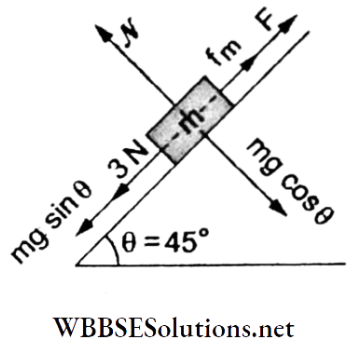
Question 35. A spring of unstretched length l has a force constant of k. It is cut into two pieces of unstretched lengths l1 and l2, where l1 = nl2, n being an integer. The ratio \(\frac{k_1}{k_2}\) of the corresponding force constants will be equal to
- n²
- n
- \(\frac{1}{n^2}\)
- \(\frac{1}{n}\)
Answer: 4. \(\frac{1}{n}\)
For a spring,
⇒ \(k \propto \frac{1}{l} \Rightarrow k l=\text { constant } \Rightarrow k l=k_1 l_1=k_2 l_2\)
Hence, \(k_1=\frac{k l}{l_1} \text { and } k_2=\frac{k l}{l_2}\)
∴ \(\frac{k_1}{k_2}=\frac{\mathrm{kl} / l_1}{\mathrm{kl} / l_2}=\frac{l_2}{l_1}=\frac{l_2}{n l_2}=\frac{1}{n}\)
Question 36. A particle of mass m is moving in a straight line with a momentum p. Starting at t = 0, a force F = kt acts in the same direction on the moving particle dining a time interval T so that its momentum. changes from p to 3p. Here k is a constant. The value of T is
- \(2 \sqrt{\frac{k}{p}}\)
- \(\sqrt{\frac{2 k}{p}}\)
- \(2 \sqrt{\frac{p}{k}}\)
- \(\sqrt{\frac{2 p}{k}}\)
Answer: 3. \(2 \sqrt{\frac{p}{k}}\)
The linear impulse delivered to the particle is
⇒ \(\int F d t=\int_0^T k t d t=\frac{k T^2}{2}\)
According to the impulse-momentum theorem,
⇒ \(\frac{k T^2}{2}=\Delta p=p_f-p_i=3 p-p=2 p\)
⇒ \(T=\sqrt{\frac{4 p}{k}}=2 \sqrt{\frac{p}{k}}\)

